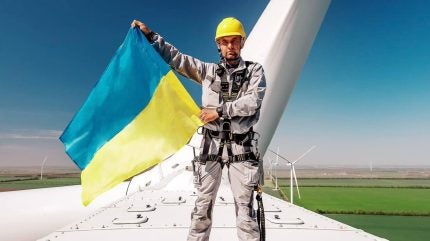
Europe must move away from LNG and take a lead on renewables from Ukraine write Svitlana Romanko, founder and executive director of Razom We Stand, and Esther Bollendorff, senior gas policy coordinator at Climate Action Network (CAN) Europe.
Three years after the full-scale invasion of Ukraine, laying bare Europe’s dependence on Russian gas and triggering an unprecedented energy crisis, the EU is still highly dependent on fossil gas.
This is driving high energy prices and, rather than implementing structural changes, politicians seem to only know two solutions to the predicament – buying more US liquefied natural gas (LNG) to placate US President Donald Trump on tariffs or U-turning to buy Russian gas in exchange for peace in the region. In Europe, governments keep doubling down on costly LNG gas infrastructure overbuild that prolongs dependence rather than fostering resilience. But they have forgotten that gas addiction is an economic time bomb.
Gas was once marketed as a cheap and secure option, driving Europe’s stark reliance on Russian supply. It turned out to be neither. Today, LNG is being positioned as an alternative, but it carries the same financial and security risks as there is a close correlation between high electricity prices and volatile gas costs. What was once promoted by some as an “affordable bridge fuel” in the transition to cheaper clean energy has become synonymous with economic turmoil and geopolitical risk, harming European industries and households with massive price increases. More and more companies are turning their back to dirty and costly fossil gas, recognising the benefits of clean energy, especially its affordability.
Ukraine’s energy transition: a blueprint for Europe
The European Union’s continued reliance on Russian fossil fuels has not only limited the EU’s options to respond to the invasion of Ukraine but also continues to finance the Kremlin’s war machine. Every shipment of Russian LNG entering European ports funnels critical revenue to Moscow, undermining the EU’s values and security. Despite existing sanctions, Russian LNG imports to the EU soared to record levels in 2024 – an alarming 19.3% increase from the previous year. This dependency represents both a moral and a strategic failure.
Amid the devastation of war, Ukraine is charting a path in the energy transition, offering a blueprint for Europe’s future. Projects like DTEK’s Tyligulska Wind Power Plant and the “50 Solar Hospitals” campaign from the Energy Act for Ukraine Foundation demonstrate the resilience of decentralised renewable systems. In liberated regions, small-scale solar and wind installations are providing reliable, independent energy – proving that decentralised renewables are less vulnerable to attacks than traditional grids.

US Tariffs are shifting - will you react or anticipate?
Don’t let policy changes catch you off guard. Stay proactive with real-time data and expert analysis.
By GlobalDataUkraine’s experience underscores a vital lesson: old, centralised energy systems are fragile in the face of conflict and other disruptions, such as the escalating impacts of climate disruption. The idea that Europe cannot function without Russian energy from fossil fuels is outdated. In 2024, nearly 47% of the EU’s electricity came from renewable sources.
Europe should learn from Ukraine’s hard-earned insights to build an energy-secure, fossil-free future unshackled from autocratic regimes. Europe must overcome its addiction to dirty Russian fossil fuels with cheaper renewable energy sources. This transition strengthens energy security, according to both the IMF and the EU. It also drives economic savings and growth, creates jobs and paves the way for a resilient and independent energy future. In fact, building a 100% renewables-based energy system by 2040 could generate economic and social benefits worth €1trn by 2030.
LNG: A false solution
However, the EU has failed to learn lessons from its gas dependency. In the scramble to replace Russian pipeline gas, the EU turned to other suppliers. Norway and the US became the two most important suppliers for the EU in 2023. The EU remains highly dependent on fossil gas imports, with 90% of its supply coming from outside the EU. Today the US is the largest LNG supplier to the EU, representing almost 50% of total LNG imports. Most of this is fracked gas, extracted through a process that is banned across much of Europe, shifting responsibility for EU climate damage and pollution elsewhere. Importing more foreign LNG creates significant geopolitical and financial risks while deepening the climate crisis. Instead of energy security, it locks Europe into costly long-term dependence on volatile and risky global LNG markets controlled more by Qatar, Russia and the US than the EU.
Beyond the immediate cost of gas imports, Europe’s massively subsidised and wasteful LNG infrastructure choices set it up for long-term economic pain. Since 2015, €50bn has been allocated to fossil fuel assets through capacity markets, maintaining a financial support system for outdated energy sources. The EU continues to pour billions into yesterday’s fuels when renewables like solar power create jobs, drive down electricity prices across Europe and contribute to the decline of fossil fuels.
The EU’s crossroads: dependence or resilience?
The coming months will be a crucial test for the EU’s energy and economic strategy. The EU’s upcoming roadmap to phase out Russian fossil fuels and the revision of the Security of Supply framework must reflect the reality that gas is a financial liability, not an asset. Renewables and energy savings are essential for economic resilience, peace, and long-term stability. Europe is at a turning point: it can either remain locked into fossil fuels, prolonging instability and fuelling crises, or move towards a safe and prosperous future with affordable, clean energy solutions. The choice is clear, and action is needed now.



